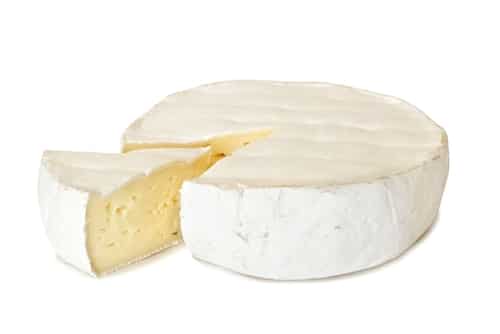Brie is a decadent cheese that’s a favorite among many due to its unique taste and texture. With its decadence comes a relatively steep price tag. So, when you spot some brie on sale, it’s understandable that you might stock up on more than you needed. This begs the question:
Can you freeze brie cheese?
The short answer is yes, but there are some specific techniques you’ll want to employ. Although any way you slice it (literally), freezing brie, or any cheese for that matter, will permanently remove some of its natural texture and taste.
This article will discuss everything you need to know about freezing brie.
Can You Freeze Brie?

The question “can you freeze brie cheese” depends on the level of freshness you hope to expect as well as what type of dishes you wish to make with it.
Freezing will always change the texture of cheese. For instance, it won’t be the same texture as you’re used to when fresh and can feel slightly dry. Also, its unique flavor will become a bit more subtle or mild.
The quality of the brie will heavily depend on your freezing method (in this article, we’ll outline two). The primary technique of retaining as much freshness as possible will be by wrapping small pieces of brie and doing so tightly.
If you don’t have enough time to go about this method effectively, you can most certainly make it a quicker process. In this case, it’s best to serve the brie cooked or melted, so the change in texture and taste is not as noticeable.
How to Freeze Brie
As we mentioned, there are two main methods of freezing brie cheese. The first method is for those who prefer some convenience and don’t have a lot of time dedicated to the process.
Again, this method will retain less freshness than the second method and is best for those who plan to use the brie in a cooked or melted recipe.
Method 1
You’ll need the brie cheese, a baking tray, mat, or parchment paper, and a freezer bag or container for this method.
Step 1:
Begin by slicing the brie. You’ll want to consider how you plan to prepare the cheese to determine the thickness of the slices. For example, stews or sauces can do fine with a few thick slices, but you’ll want small, thin slices for bread or crackers.
Step 2:
Pre-freeze the slices. Lay the parchment paper (or any other non-stick paper) over the cookie tray and place the slices in a single layer about an inch away from each other. Put the tray in your freezer and leave it either for a few hours or overnight.
Step 3:
After some time has passed, you may transfer the slices from the tray to your freezer bag or container. Labeling it with the date can be helpful.
Method 2
For this method, you’ll need the brie cheese, a freezer bag, and something to wrap the cheese in, such as parchment or wax paper. Do not use saran wrap as it will adhere to the cheese once it has thawed.
Step 1:
Slicing the cheese with this method is suggested but not necessary. You may want to think about how often you’ll need the cheese in the future. If you decide against slicing, you’ll need to ensure you use the whole wheel within a short amount of time, as we do not recommend re-thawing cheese.
Step 2:
Tightly wrap the cheese or its slices individually with the wrapping paper you chose. No surfaces of the cheese should be exposed, and the wrap should securely in place.
Step 3:
Transfer the wrapped-up pieces into the freezer bag. Before sealing the bag, try to remove as much air as possible. With this method, it’s even more imperative to label the bag with the date. Place in the freezer and take as needed.
How Long Will Brie Last in the Fridge/Freezer?

Typically, brie can last in the fridge for about two to three weeks upon arrival at the supermarket. You should check the best by date on the label before deciding to freeze it. If the expiration date is relatively soon, it may not make sense to freeze it at all. You should keep it in the fridge and try to use it up within a week or so.
When storing frozen brie in the freezer, it should retain its freshness for three to six months. As with all frozen food, the quality and freshness will gradually decline over time, so the more quickly you consume it, the better.
You don’t have to dump the cheese right away if you’ve surpassed six months, but it’s a good idea to allow it to thaw in the fridge and assess it then. You should throw it out if you notice it looks bad.
Once the brie has thawed after being frozen and kept refrigerated, it’s best to eat it within a day or two. After three days, you should throw the thawed brie out. Much like with meat, it’s unsafe to refreeze cheese that has already been thawed and then refrozen.
How to Thaw/Defrost Brie
You can use three main methods when it comes to defrosting the frozen brine.
The most recommended option is to defrost it in the fridge. While this method takes the most time, it’s the safest way. Leave the frozen pieces you wish to use in the refrigerator overnight. By morning they should be ready. If you find the texture is too hard, allow a bit more time.
You may also place the pieces you want into another bag and submerge it into a bowl of cold water. Allow it to stay submerged for two to three hours.
If you plan to cook the brie into a stew, soup, sauce, or baked dish, it’s perfectly fine to do so frozen. However, you’ll want to ensure the slices are exactly how you need them, as attempting to slice the cheese while firmly frozen will be nearly impossible.
How to Tell If Your Frozen Brie Has Gone Bad
To check if you’re defrosted cheese is starting to go bad, there are some signs of spoilage you can look for. These include:
- Mold or discoloration not native to the cheese
- An unpleasant, ammonia-like odor
- A hardened texture
- A foul taste
Avoid cutting off any moldy parts you notice on the brie and eating the rest. Unlike hard cheeses like Parmesan, soft cheeses allow mold to spread quickly, even if it’s not particularly visible.
Things to Do with Frozen Brie
If you plan on eating the defrosted brie fresh, a good practice is to let it warm up at room temperature for about 30 minutes first for optimum taste and texture. If you froze the brie using the second method, you can pretty much make anything you’d like with it.
If you decided on the first option, you will want to stick to dishes in which you cook the brie, so the change in taste and texture is less noticeable. Lovely recipes with brie include soups, sauce, casseroles, stews, or simply melting it on top of bread or other dishes.
One quick and simple recipe is Toasted Brie with Basil and Oregano:
Step 1:
Preheat your oven to 360°F (or 180° C). You can use a toaster oven for this as well.
Step 2:
Slice your choice of bread and the brie. Lay the brie slices over the bread and sprinkle each piece with dried spices like basil and oregano.
Step 3:
Line your baking sheet with foil or wax paper and place the toasts on it. Bake for about five to ten minutes, depending on the thickness of the bread and the brie.
Final Thoughts
In conclusion, we all know that brie tastes best when bought and eaten fresh. But can you freeze brie cheese? Indeed, you can as long as you’re aware that a subtle hint of the flavor and texture will be lost in the process.
If you need to get the job done quickly, it’s recommended that you only use the thawed brie for melted dishes. If you can stand to slice the brie and wrap the slices individually and tightly, you can maintain a good amount of freshness and can then eat the brie however you’d like.
It’s important to check the brie once it has been thawed to ensure it has not gone bad. And under no circumstances should you refreeze the already defrosted cheese, which can cause serious health risks.
When eating thawed brie fresh, it’s suggested to do so on your own for cooked dishes, rather than adding it to a cheese platter at a dinner party or serving it to your guests. Brie tastes best when bought and served fresh. But there is an endless variety of cooked dishes that thawed brie tastes great in once melted.







I like frozen brie in baking with puff pastry and jam, you don’t notice the change in taste, and it makes great appetizers…